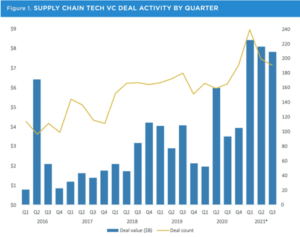As the US hits the two-year anniversary of the first case of COVID-19 in the US in January of 2020, the second-order effects of COVID-19 continue to pose major obstacles to global supply chains. Supply chain constraints have become the norm over the past two years with no end in sight. At the time of writing, China, representing approximately one third of global manufacturing, has begun imposing lockdown restrictions in an attempt to reduce the spread of the Omicron variant – an action with the potential to send further shockwaves throughout an already crippled global supply chain.
Through adversity comes strength, and venture capital has found an opportunity to pour gasoline on the fire that is the innovation in the supply chain technology space. In Q3 2021, venture capital investment in supply chain technology topped $7.8 billion, an over 100% year-over-year increase. From cloud supply chain companies like Stord, who recently raised a $90 million Series D and who offers fulfillment, warehousing, and freight for B2C and B2B, with the integrated software needed to orchestrate and optimize supply chains, to last-mile delivery companies like goPuff, who aims to provide daily essentials delivered in minutes and recently raised a $1 billion Series H, supply chain technology companies have seen unprecedented investment as consumer needs and behaviors continue to adapt through the pandemic.

(Source: Pitchbook Emerging Tech Research: Supply Chain Tech Q3 2021)
What does this mean for the supply chain coming into 2022? With the immense influx of venture capital into supply chain technology in 2021, 2022 could be the most crucial year for evaluating and leveraging these new technologies to gain a competitive advantage in the market. According to a McKinsey & Company study on how COVID-19 is reshaping supply chains, while companies have strong intents to increase their investment in supply-chain visibility, only 39% of companies have prioritized supply-chain disruption monitoring as part of their digital investment strategy moving forward, an area where agility is sure to become a differentiator as the impact and volatility of supply chain disruptions continue to impact operations in the future.

With supply chains being tested from all angles – from labor shortages to surging freight rates to supplier lockdowns to a variety of other issues – there could not be a better time to evaluate the state of your supply chain and leverage new technologies to both address the many issues being faced today and prepare for the obstacles of the future.
Struggling to know where to begin in this vast landscape of technological options? Looking to gain a competitive advantage through the design of cutting-edge supply chain solutions? Reach out today to our team of supply chain technology experts at info@bricz.com and let us help you navigate your technological options, develop agile solutions, and build a more resilient supply chain in 2022.
Contributor: Jack Dwyer, Supply Chain Consultant at Bricz
